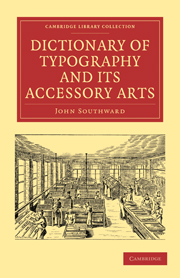Summary
KEEP IN.—A direction given to a compositor in order that lie may bring his composition within a certain limit. To do this he sets closer than usual.
KEEP OUT.—See Drive out.
KERN OF A LETTER.—The part of the face of a letter which hangs over the beard of its shank. In roman f and j are the only kerned letters; hut in the italic d, g, j, l, y are kerned on one side, and f on both sides of the face. Many italic capitals are kerned on one side of the face.
KNOCK UP.—In warehouse work, to knock up paper is to get it into such a condition that each sheet exactly covers, but does not overhang at any edge, the sheet below. The sides of the heap, after the paper has been properly knocked up, should present the appearance of a perfectly smooth surface. The warehouseman takes up a small quantity of paper (according to the stoutness or flimsiness) and holding it loosely at the edges with both hands, he bends the ends slightly towards him so that the paper shall form a curve; he then lifts it up a little from the table and lets it drop upon its edge through his hands—the curve giving the edge a certain firmness, many of the sheets drop down into their places ; he repeats this two or three times, and will then, in letting it drop upon the table, bring the lower part nearer to him, so that the outside of the curve may strike first, and throw the sheets gradually up higher at the back. This he will do also two or three times.
- Type
- Chapter
- Information
- Publisher: Cambridge University PressPrint publication year: 2010First published in: 1875



